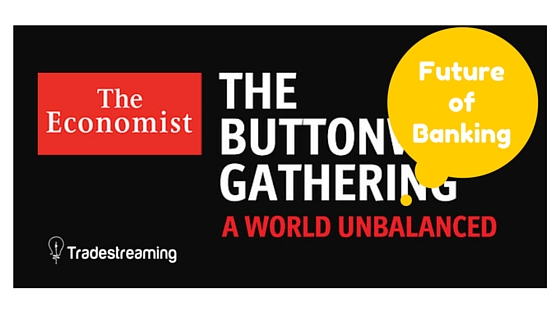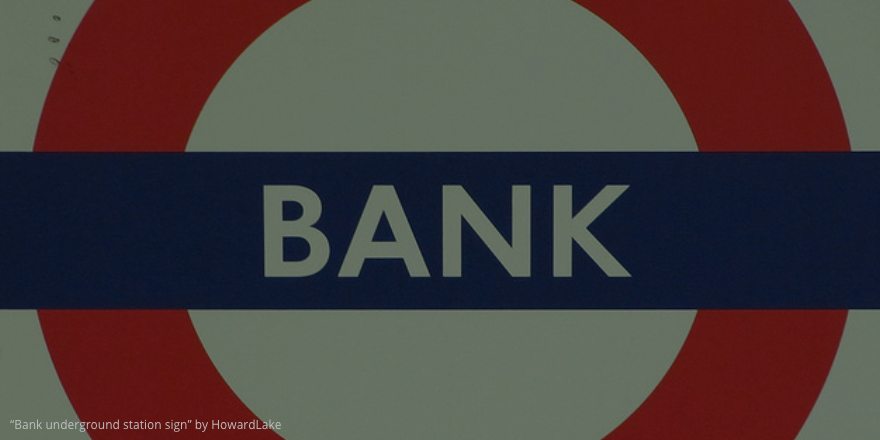What the Economist Buttonwood event has to say about the future of banking
Last week, finance’s who’s who soiréed at the Economist’s Buttonwood Gathering. The one question that seemed to underly all the discussions and break out sessions:
- what about banks?
- What’s the banking sector’s role going forward when fintech is disrupting from above, below, and laterally?
Here’s Tradestreaming’s own “gathering” of articles written this week with a variety of different viewpoints on the matter. The one thing all these viewpoints have in common is that tomorrow’s banks will look nothing like today’s. Subscribe to Tradestreaming’s weekly email to stay on top of all these trends in finance.
Economist’s Buttonwood: Banks of the future?
Build, Buy, Partner, or Ignore: Banking’s response to online lending (Tradestreaming)
Tradestreaming Tearsheet: Banks are being assailed from all sides (above, below, and laterally). Regulation doesn’t allow the sector to be too creative, creating a competitive situation for the incumbents right now. Here are 4 things they can do moving forward.
Will Fintech Upstarts Do To Banks What Uber Has Done To Taxis? (Forbes)
At The Economist’s Buttonwood conference Tuesday, Wall Street and Silicon Valley debated who will ultimately change the face of financial services in the U.S. Will the startups win, will the old guard maintain their stronghold on the industry – or will the two entities find a way to work together?
Should banks fear fintech? (BANKNXT)
José Antonio Gallego classifies disruptive companies in a novel way, highlighting those fintech startups succeeding in a changing financial world. “With this non-exhaustive overview, we have divided these [banking] companies into five different types: Sioux, Guerrilla, Samurai, Double Agents, and Invaders from Outer Space.”
Suddenly Cash is Anathema For Banks (Pymnts.com)
Tradestreaming Tearsheet: As investment managers are stockpiling cash in front of an uncertain economic future, banks are taking measures to dissuade large investors from keeping too much cash as deposits. If banks aren’t taking deposits, what are they doing? What’s an asset-light bank?
Key trends in retail banking in 2016 (BANKNXT)
Verdict Financial senior analyst Daoud Fakhri answers questions about trends in retail banking, and how the landscape will change in 2016.
Building the Framework for the Future of Banking (bank innovation)
“A new approach to banking technology uses an enterprise services framework to overhaul the way individual solutions are connected, supporting comprehensive, real-time information sharing. This advanced integration environment brings together cloud, mobile, social and fast data to create a digital enterprise. And it signals a major transformation.”
Fintech is creating creative pressure on the incumbent banking infrastructure, stealing bread-and-butter business from the banks. Regulation makes it hard for banks to compete while many fintech firms can continue to fly under the regulatory radar. All signs point to the fact that future banking will look very different than it does now.
[x_share title=”Share this Post” facebook=”true” twitter=”true” linkedin=”true” email=”true”]
The Economist takes honest look at fintech
The Economist, on the eve of its Buttonwood Gathering in NYC, takes an open look at fintech, stripping away the hype to discuss the longterm prospects of fintech and how startups will continue to interact with the incumbents in the industry (namely, banks)
How Silicon Valley Will Bring Down the Banks
[x_pullquote type=”right”]If you look ahead 5-10 years the things that put banks under most pressure today, notably, regulation, will be the things that ultimately protect them[/x_pullquote]In this edition of the Economist’s Money Talks, banking editor, Stan Pignal talks to American finance editor, Tom Easton and the duo spend a lot of time analyzing the banking system: its current strengths and weaknesses and what it may look like 5-10 years out.
It’s actually a pretty dour outlook for today’s banks, according to Pignal and Easton. It seems the only hope the incumbents have is current regulation.
What happens to Marketplace Lenders during a crunch
Next up in the discussion were marketplace lenders, like Lending Club and Prosper. Both participants are surprised that banks hadn’t gotten into this business in a bigger way.[x_pullquote type=”left”]Weren’t banks designed to be marketplace lenders from the onset?[/x_pullquote]
Since the lenders on these platforms haven’t been through a full credit contraction cycle while using the marketplace lending platforms, it’s going to get interesting when these lenders suffer losses for the first time. What happens then?
Pignal and Easton make it clear that banks will never again look like their former selves but regulation will ensure their endurance in a more limited capacity. The competition from startups in the fintech space should force the banks to sharpen their games and specialize in delivering the services they can deliver profitably under the current regulatory regime.
Today’s bankers, tomorrow’s fintechers
The podcast draws to a close with the observation that if you head to a bank, take a look around. It’s clear: bank employees and bank management are not happy. But if you look at fintech firms, people are happy and optimistic about the future.
What’s interesting, note the two hosts of the podcast, is that fintech firms employ people who used to work for banks. They conclude that if bankers are to have joyful futures, it will be working at fintech firms.
Why I wouldn’t want to be a bank in this market
 As the late Rodney Dangerfield put it so eloquently, banks don’t get no respect in today’s market.
As the late Rodney Dangerfield put it so eloquently, banks don’t get no respect in today’s market.
It’s not that they haven’t tried. Post the 2007-2008 credit crisis, many of them have cleaned up their acts.
- they’ve stopped predatory lending (well, kinda)
- they’ve shored up their capital reserves (actually, they have to add another $68 billion against future financial disasters)
- they’ve shut down underperforming branches (truth is, they can’t close ’em fast enough)
But, it’s not just the fact that banks are now forces to lay in their own financial beds that has made bankers lives so tough of late.
Banks face (new) tough competition
It’s also about competition. Banks are being assailed on all fronts in a way they’ve never been threatened and I think the writing is one the wall: the core functions of banking are being challenged by a whole new generation of startup financial service providers that may eventually displace them. We’re in the early stages of sprinting a marathon to build the most influential finance companies.
Today’s consumer lending: from the consumer to the consumer
One of retail banking’s bread and butter business lines is a basic form of lending arbitrage. They take deposits from customers (paying out a low interest rate) and then lend it out to other customers (at a higher interest rate).
But many individuals are borrowing outside traditional banking channels. Lending Club, the largest peer to peer lender, just surpassed $4 billion in small personal loans it’s underwritten on its platform. Borrowers on peer to peer lending platforms either couldn’t qualify for loans, got worse rates with banks or just would rather avoid the banking sector all together. Banks see the writing on the wall — Union Bank just announced it would team up with Lending Club to deploy its own capital into loans on Lending Club’s website. You can hear how far the company has come since my 2012 interview with Lending Club founder and CEO.
Business loans: the next domino to fall
Lending Club made it very clear as it gears up for its own multi-billion dollar IPO (expected this year) that it’s interested in getting into business loans. It’s here, in the commercial loan business, that banks are facing their fiercest rivals right now.
- Long term loans: Newly-minted companies like Funding Circle has already lent out hundreds of millions of dollars to business looking to borrow money for years at a time. The demand for these types of loans from non-banking sources is huge.
- Short term loans: Businesses looking for shorter term loans and access to working capital are turning more and more to companies like OnDeck. Armed with new credit models, these firms can frequently be more quick and nimble, approving loans in minutes (versus days and weeks at traditional lenders).
- Specialty loans: Perhaps the most interesting entrants into the online lending market are the specialty ecommerce and payment platforms. Amazon is hiring boatloads of people to staff up its new lending division. Paypal is doing the same with its new Working Capital loans for small businesses that use the payment platform. These companies are perfectly situated in their customers’ business to a) determine creditworthiness and b) to provide them with a loan. And student loans? Forget about it — there are startups like Pave (hear my recent interview with Pave’s co-founder) trying to create more efficient (and cheaper) ways to finance higher education.
Look for more innovative online lending models to proliferate in the next few years like the kind that Zazma employs. A startup that’s received investments from top venture capital firms, Zazma provides trade financing to small businesses. Need to stock up on some inventory before the holiday season? Zazma will pay your supplier for the goods and work with you on payback — all almost instantly online. Low friction like credit cards and quick access to working capital.
Today’s “no respect” for the banking sector is so much more than just the product of the recent credit crisis. Smart, well-funded startups are beginning to chip away at banks’ core value to the economy and consumers (both retail and business) seem to happier with their new-found options.
What do you think about the changes in the lending market? Let’s discuss in the comments below.










